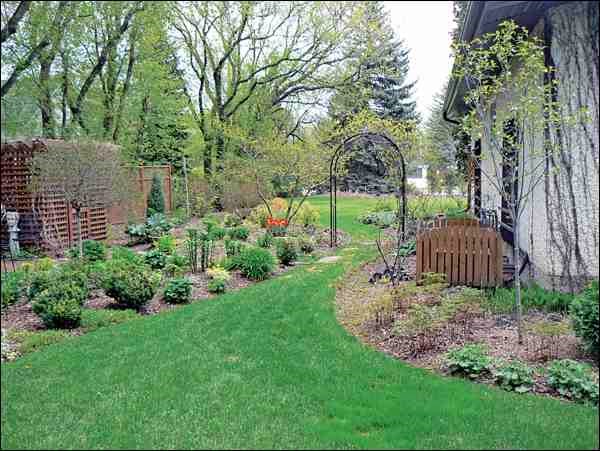A mulched border conserves water and protects your plants and soil. But it also reduces maintenance and the need for fertilizers and pesticides.
Let's begin with a definition: mulch is a layer of organic material, 10 centimetres deep, spread over the soil surface between your plants. Various types of mulch are available to prairie gardeners: post peelings, coarse sphagnum peat moss, shredded bark, decorative bark, chipper debris, evergreen needles and cones, flax straw and shives and mowed leaves. Mulching imitates nature (think of the millions of decaying leaves that cover a forest floor, or the build up of thatch in a Prairie grassland) and is an excellent way to recycle materials once destined for landfills or burning.
Water conservation. Mulching conserves water by suppressing weeds that compete with your border plants for water. More importantly, it cools the soil, thus reducing evaporation. Mulch also reduces wind evaporation. The slightly increased height of a mulched border and the rougher texture is sufficient to act as a snow trap. The extra snow insulates the plants over winter and provides added moisture when it melts in the spring.
Soil improvement and conservation. Mulch protects valuable topsoil from erosion. Mulching also prevents crusting and cracking and improves water percolation. As mulch decays over time, it releases nutrients and adds organic matter to the soil. The result is better aeration as well as improved water and nutrient-holding capacity of your soil. And the mulch layer acts as a cushion, preventing soil compaction.
Weed control. Weeds compete with flowers and shrubs for light, space, nutrients and water. By excluding light, the mulch layer prevents germination of the many weed seeds waiting in the soil below it. It also acts as a physical barrier preventing the emergence of weed seeds that do germinate. Weed seeds that blow onto the mulched surface find it difficult to root through the mulch.
Reducing water splash. Mulch absorbs water and almost entirely eliminates water and mud splash. This keeps flowers (and fruit such as strawberries) and house siding clean. But more importantly, by reducing mud-splash, mulch greatly reduces soil-borne fungal (e.g. grey mold or Botrytis) and bacterial diseases that can be transferred from the soil to the flowers, foliage and fruit from irrigation and rain.
Encouraging ladybeetles. Once a mulch layer has been in place for a year or two, gardeners will be amazed by the number of lady bugs that find a home within and under the mulch layer. Capable of eating 25 aphids per day, they are truly a gardener's friend.
Discouraging slugs. Contrary to what one might think, the coarse texture of many mulches actually reduces slug populations by rasping and dehydrating their tender bodies. Post peelings are especially good for this.
Temperature modification. Mulch insulates the soil below, moderating temperature extremes and sudden temperature swings. By cooling the soil surface during the hot days of summer, mulch encourages healthy root growth and prevents root injury caused by excessively high soil temperatures. In spring and fall, it reduces the freeze-thaw cycles of heavy soils which can cause heaving and root injury to young plants. Mulch keeps the soil cooler in early spring, preventing premature emergence of spring bulbs which might be nipped by frost.
Design function. Mulch adds subtle colour and texture to our landscapes. It unifies planting beds, especially when the plants themselves are young, small and seemingly widely spaced within the bed. Mulch lets the world know that, indeed, this is a bed and should be walked around rather than through.
- Sara Williams is the author of the revised and updated Creating the Prairie Xeriscape and with Hugh Skinner, Gardening Naturally: a chemical-free handbook for the prairies This column is provided courtesy of the Saskatchewan Perennial Society (www.saskperennial.ca; [email protected]). Check out our Bulletin Board or Calendar for upcoming horticulture events in May and June.




